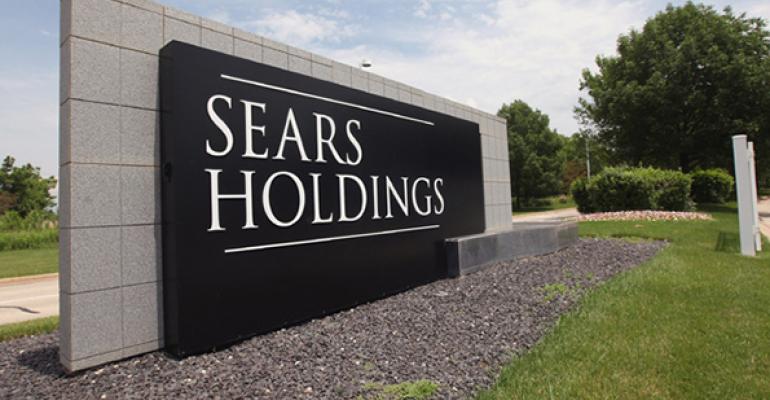Sears Holding Corp. continues to gasp for air. However, the struggling company just got some breathing room from creditors after receiving more time to refinance its debt.
In a June 4 Securities and Exchange Commission filing, Sears says it has two additional years to pay back its lenders, including Sears CEO Eddie Lampert. The company consolidated three loans, including two real estate loans, totaling $593 million, which were due next month. The new consolidated loan’s due date has been pushed out to July 20, 2020. Sears says it will also receive an additional advance of $186 million, which means the total loan due in July 2020 will be $779 million. The new loan is secured by 69 Sears-owned real estate properties.
The filing follows bleak first-quarter 2018 results. Sears posted a net loss of $424 million or $3.93 per share for the quarter. Same-store store sales fell 11.9 percent, including a 9.5 percent drop at Kmart stores and a 13.4 percent decline at Sears.
Amid dropping sales, Sears continues to slash stores to trim its real estate portfolio. The retailer has identified about 100 unprofitable stores, of which 63 will start closing “in the near future.” They include 48 Sears and 15 Kmart stores. Following these closings, Sears will operate approximately 800 stores, down from about 1,000 at year-end 2017 and 4,000 at its peak in 2012.
“Sears is obviously continuing to downsize because they’re losing money,” says Steve Jellinek, vice president at Morningstar Credit Ratings. “They’ve had a string of quarters over years of negative same-store sales. The fact that they’re losing money is prompting them to try and right-size the ship before they run out of money. They’re trying to find an adequate level of stores that they can maintain, and hopefully, turn around profitably.”
Lampert has been trying to breathe new life into the company by closing unprofitable stores and also selling or spinning off assets—anything to generate cash flow. He’s already sold off Lands' End and the Craftsman tool brand. Despite these efforts, Sears has lost approximately $11 billion since 2012.
Now ESL Investments, a hedge fund that Lampert runs separately, is looking to buy Sears’ Kenmore appliance brand, some of Sears’ Home Services businesses, and some remaining real estate. Sears also inked some deals with Amazon.
“The last two to three years has just been sort of a series of stopgap maneuvers to be able to stretch out maturities and to do other things to solve short-term liquidity issues, because the company burns through about $1.5 billion a year,” says Noel Hebert, a senior credit analyst for Bloomberg Intelligence.
Sears’ stock has plummeted 70 percent over the past 12 months. In 2007, shares hit an all-time high of $195.18. During the past week, shares were trading at around $2.48. The company’s revenue has dropped every year since 2007, and it hasn’t turned a profit since 2010.
What’s next for the troubled retailer?
While the loan extension may buy some time for Sears, industry experts say the odds of a successful turnaround are slim. Stores are outdated, they have little brand recognition and shoppers have many other choices.
“The extension doesn’t change anything,” says David Weiss, a partner at Chicago-based consulting firm McMillan Doolittle. “Sears continues to pursue financial strategies that extend the life of the corporation. The goal isn’t to use that time to save the stores. If it were, we would hear less about financial strategies and more about retail ones. When we do hear management speak about retail, they cite the Shop Your Way program (its customer loyalty program), which they’ve talked about ad nauseam since 2013, and which has proven not to benefit the overall health of the company.”
Or, Weiss notes, management talks about retail strategies and the peripheral businesses: Sears Automotive, Home Services and brands like Kenmore.
“The creditor relief gives management time to strengthen these tertiary assets—in the case of Sears Automotive—by building a partnership with Amazon,” Weiss say. “It strengthens them in order to sell them.”
He notes Sears will go out of business regardless of the creditor relief.
“Sears offers little of relevance to the consumer,” he says. “Why would a consumer visit a Sears today rather than a Kohl’s, Home Depot, Amazon, Target, Walmart? What makes Sears special? Not much.”
It’s been an “ongoing drama where at least every year you enter with a Sears’ death spiral,” adds Hebert. “I’ve got clients where at the end of any given year, you’re heading into the holidays, and everybody’s trying to pick the bankruptcy date. Nobody has been right so far. It isn’t going to go too much further just because at this stage, there isn’t a lot left to sell. They can certainly navigate 2018 with a couple more maneuvers.”
Herbert notes that the great conundrum is if Sears had filed for bankruptcy in 2017, there would still be 400 to 500 Sears stores around the country. The company would “stay with their best locations” and have capital to reinvest in them.
“But they’ve run this thing so far down the hole,” he says. “And to use the old analogy of the melting ice cube, there’s not a whole lot of ice left. I think it’s a much bigger question mark now whether there’s an actual salvageable retail business behind this anymore, because it has just fed on itself so much.”

